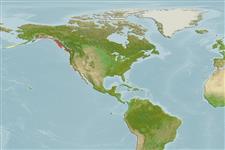Common names from other countries
Environment: milieu / climate zone / depth range / distribution range
Ecologia
; intervalo de profundidade 0 - 15 m (Ref. 1745). Boreal
Eastern Pacific. Boreal to subtropical.
Length at first maturity / Tamanho / Peso / Idade
Maturity: Lm ? range ? - ? cm Max length : 10.0 cm COLD macho/indeterminado; (Ref. 865)
Minimum depth from Ref. 865. Found in rocky intertidal and low intertidal areas (Refs. 1745, 865). Colonial (Ref. 2268).
Life cycle and mating behavior
Maturidade | Reprodução | Desova | Ovos | Fecundidade | Larvas
Members of the class Ascidiacea are hermaphroditic; both cross- and self-fertilization is typical. Life cycle: Eggs develop into lecithotrophic larva before metamorphosing into benthic adults.
Lambert, G. and K. Sanamyan. 2001. (Ref. 1745)
Categoria na Lista Vermelha da IUCN (Ref. 130435)
Categoria CITES (Ref. 108899)
Not Evaluated
Not Evaluated
Utilização humana
| FishSource |
Ferramentas
Mais informação
Idade/TamanhoCrescimentoComprimento-pesoComprimento-comprimentoMorfologiaLarvasAbundância
Fontes da internet
Estimates based on models
Preferred temperature
(Ref.
115969): 6 - 15.9, mean 9.1 (based on 369 cells).
Categoria de preço
Unknown.
